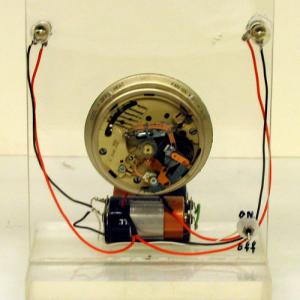College of Liberal Arts & Sciences
4A30.11 - Bimetal Strip Thermostat
Hold the grill lighter flame under the curved part of the thermostat. After a few seconds the blue light should go out and the red light should come on. Pour distilled water over the curved part of the thermostat and this should cool it down enough to make the blue light come on again.
This thermostat is the typical home thermostat with a mercury switch atop a bimetal coil. Adjust the thermostat so that the lights are on at room temperature. Heat the coil with the flame from a grill lighter, and the coil will expand turning the lights off. Cool the coil with some water and the lights will go on again.
- H. Richard Crane, "Popping Bimetal Can Keep You Warm or Cool", TPT, Vol. 36, # 5, p. 302, May 1998.
- Jay S. Huebner, "Thermal Switch Oscillators", AJP, Vol. 55, #10, Oct. 1987, p. 954.
- H- 044: "Thermostat - Auto - Stove - Bimetal", DICK and RAE Physics Demo Notebook.
- George M. Hopkins, "Simple Thermostat", Experimental Science, p 183.
- Martin C. Sagendorf, "All Matter Expands When its Thermal Energy (Temperature) is Increased", Physics Demonstration Apparatus, 2009, p. 13.
- Jodi and Roy McCullough, "Thermal Expansion with a Flashing Bulb", The Role of Toys in Teaching Physics, p. 4.128.
- C. L. Stong, "An Electrometer, a Temperature Control Apparatus, and a Simple Electric Motor", The Amateur Scientist, October, 1965.
Disclaimer: These demonstrations are provided only for illustrative use by persons affiliated with The University of Iowa and only under the direction of a trained instructor or physicist. The University of Iowa is not responsible for demonstrations performed by those using their own equipment or who choose to use this reference material for their own purpose. The demonstrations included here are within the public domain and can be found in materials contained in libraries, bookstores, and through electronic sources. Performing all or any portion of any of these demonstrations, with or without revisions not depicted here entails inherent risks. These risks include, without limitation, bodily injury (and possibly death), including risks to health that may be temporary or permanent and that may exacerbate a pre-existing medical condition; and property loss or damage. Anyone performing any part of these demonstrations, even with revisions, knowingly and voluntarily assumes all risks associated with them.

